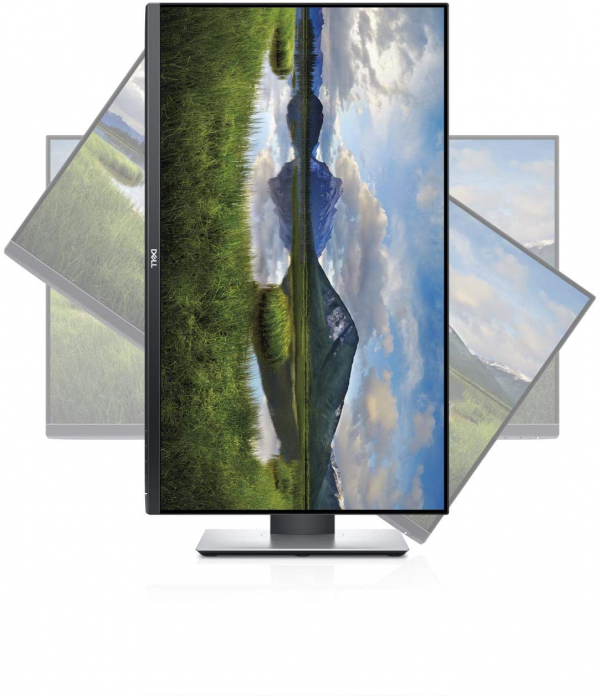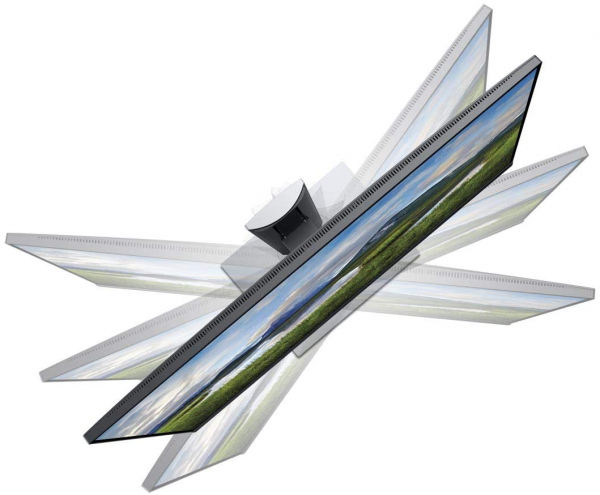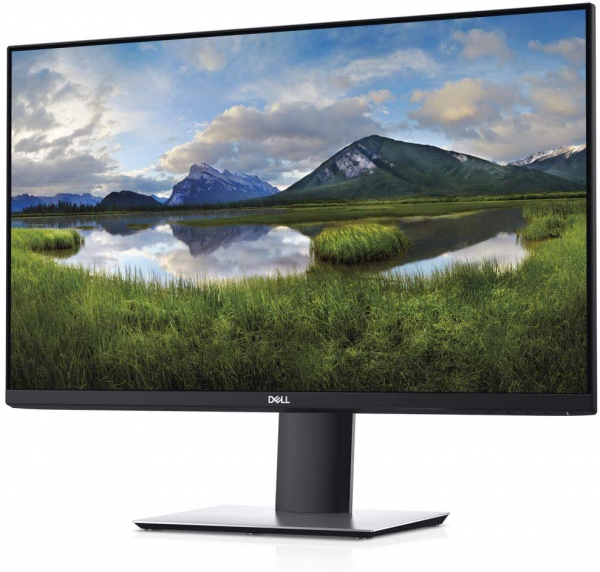Dell
27-inch Dell P2720DC display with USB-C: ideal for accompanying a laptop
Aprox. 317€
See specificationsThe Dell P2720DC is a versatile monitor with a 27-inch IPS panel in Quad HD definition and, above all, a USB-C port that can charge a laptop up to 65 watts. It remains to be seen whether he keeps his promises ...
Positive points
Default image quality.
Design.
Finish.
USB-C port delivering 65 watts.
4 USB 3.0 ports including two on the edge.
Reduced consumption.
3 year warranty.
Bad points
Contrast and average afterglow.
Lack of built-in speakers.
No Ethernet port.
Our review
Presentation
The Dell P2720DC has a 27-inch IPS panel with a Quad HD definition of 2,560 x 1,440 px. The manufacturer announces a contrast of 1000: 1, a response time of 5 ms, viewing angles of 178 ° and a maximum brightness of 350 cd / m². It stands out from the competition by its original connection consisting of a DisplayPort input, a DisplayPort output (for chaining several monitors), an HDMI input, four USB 3.0 ports and a USB-C port supporting up to 65 watts. The latter allows you to transfer the video signal, connect USB devices and charge the laptop using a single cable.
The Dell P2720DC is sold for around € 390 at Dell, but it is sometimes found for less at certain resellers. It competes with the Philips Brilliance 258B6QUEB, better equipped with an Ethernet port and speakers, but with a panel of only 25 inches.

Ergonomics
As often at Dell, the design is very classic and versatile. The finishes are exemplary and the whole exudes quality. The black plastics are of good quality, well finished and nothing cracks. The matt slab filters all the reflections.
The ergonomics of the Dell monitor are exemplary. The foot is adjustable in height by 13 cm, in inclination from -5 ° to + 21 ° and is oriented by ± 45 °. The panel can also switch to portrait mode. As often with Dell, the various adjustments are made smoothly, without any noise, which is a guarantee of quality.
No frills on the back of the monitor. The matt black plastic is of high quality. The connectors are placed on the lower edge of the screen and the opening at the base of the stand serves as a cable passage.
The connection consists of an HDMI 1.4 input, a DisplayPort input, a DisplayPort output hidden by the orange cover (for chaining a second screen), a USB-C port and a hub with 2 USB 2.0 ports placed on the back and two USB 3.0 ports judiciously placed on the edge. This monitor skips the headphone output and the built-in speakers. The USB-C to USB-C cable supplied with the monitor allows you to charge the laptop, use the two USB 2.0 ports on the back to connect a keyboard and a mouse, for example, as well as the two ports USB 3.0 located on the edge and send the video signal to the screen. In short, a single cable is enough to transform the monitor into a sort of docking station. The screen can copy from the computer screen or expand its display. The Dell P2419HC's USB-C port can provide 65 W and can therefore be used to charge almost all portable computers on the market. Only the most powerful computers, such as the 15-inch or 16-inch MacBook Pro, whose original power supply delivers more than 85 watts, will be affected. In fact, it works perfectly and the power is used at full speed only during heavy loads. In the case of the 15-inch MacBook Pro, the battery takes over if the power required is too large. Finally, we can regret the absence of an Ethernet port which could have transformed the monitor into a real docking station, but we can then go through a USB to Ethernet adapter.
Dell had the good idea to place two USB 3.0 ports on the edge, which is very convenient to connect a USB key or an external hard drive. This is all the more interesting since the USB-C port allows you to use all these additional USB ports on a laptop without having to use an additional cable.
The five buttons at the bottom of the screen on the right give access to the different settings. Fortunately, the power button is very separate and distinct, which prevents handling errors. This system is still less practical than the clickable joystick used by competitors, but the menus are fairly clear.
The Dell P2720DC monitor is comfortable on our reference desk measuring 140 x 60 cm. With its Quad HD definition, it offers a good compromise between compactness on the desktop and comfortable workspace under Windows or macOS. The resolution remains quite fine (109 pixels per inch) and some will be tempted to use on-board scaling in modern operating systems in order to adapt the size of the fonts. Of course, the built-in USB-C port makes it a perfect companion for compatible laptop users. Finally, a small detail that is important, Dell P-series monitors have a warranty against dead pixels and a 3-year warranty by a standard exchange.
When we lower the brightness to 40% to obtain a white at 150 cd / m², the Dell P2720DC consumes only 15 W, or a relative consumption of only 75 W / m², much lower than the average of the monitors in our comparison (100 W / m²). Consumption goes to 34 W when the brightness is pushed to the maximum (357 cd / m²) and drops to 7 W at minimum (18 cd / m²).

Colors and contrast
What can I say except that the Dell P2720DC offers excellent image quality right out of the box. We have thus noted an average gamma of 2.2 practically set on the reference value and a Delta E of only 2.4, below the threshold of 3 below which the eye no longer differentiates between ideal colors and colors displayed. However, some shades exceed a Delta E of 4, such as red, green, blue and magenta. With an average of 6,570 K and a stable curve, the color temperature is simply perfect.
By lowering the brightness to 40% to obtain a white close to 150 cd / m², the results are identical. The temperature measured at 6,570 K is still very close to the video standard (6,500 K), the gamma curve shifts to 2.2 and retains its small imperfections and the color accuracy can always be considered very good with a Delta E average of 2.3.
Calibrating the screen using a probe does little and just smooths out the gamma curve. The color rendering is slightly better (average delta E at 2.2), but the Delta E measurements of green, red, blue, cyan and yellow remain greater than 3. The most demanding users will turn to a professional monitor like the Asus ProArt PA32UC which delivers truly perfect colors, but which is much more expensive. You can download this color profile by following this link.
The contrast ratio measured at 1040: 1 is fairly average for an IPS panel; since the best IPS panels exceed 1,200: 1, like that of the Philips 276E7 or the Asus TUF VG27AQ. Most IPS monitors display a contrast of 1000: 1. This contrast is not a problem for use in broad daylight, but in the dark, this results in faded blacks. In all cases, this remains far from the contrast offered by VA panels, whose best representatives, such as the AOC Q3279VWF, the Philips BDM4037UW, the Philips Momentum 436M6 or the MSI Optix MAG271CR exceed a rate of 4,000: 1.
The average difference in white homogeneity is 7% on this 27-inch panel. There is thus no variation in the brightness perceptible to the eye. We did not see any light leaks in the corners or any clouding ("cloud effect") on our test model. IPS technology offers very wide viewing angles and there is very little variation in brightness or colorimetry at 45 °.

Reactivity
The Dell P2720DC does not use Pulse Width Modulation (PWM) to adjust the brightness; it is therefore devoid of flicker and does not cause headaches for those who are sensitive to this phenomenon. This screen also incorporates a blue light reduction system called ComfortView. It is not compatible with FreeSync and G-Sync dynamic refresh rate technologies.
Setting the overdrive to "Normal" results in the presence of a slight * ghosting * effect ("ghost image effect"). The "Fast" setting, on the other hand, causes a rather annoying reverse ghosting phenomenon. With the "Normal" setting, we measured a remanence time of 11 ms, correct for an IPS monitor, nothing more. The fastest IPS monitors, like the LG 27GL850, go below 8 ms. This 11 ms afterglow remains acceptable for video and multimedia tasks. Obviously, it poses no problem in office automation. However, video game enthusiasts will turn to a slightly more responsive monitor. Finally, we measured the delay in the display (input lag) at 9.1 ms (at 60 Hz). It is excellent value. There is no lag between the action with the mouse and its repercussion on the screen.

Conclusion
The Dell P2720DC is an excellent monitor for office and multimedia applications. Its ergonomics are impeccable and the integration of a USB-C port delivering 65 watts allows it to be transformed into a small docking station for laptops equipped with the same connector. In addition, it delivers a perfectly calibrated image right out of the box and is covered by a 3-year warranty. We can simply blame it for its slightly high afterglow and its barely average contrast. For the rest, it's flawless.
Specifications

